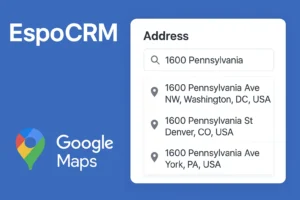Relations in EspoCRM
EspoCRM provides several types of relations between entities in the system. Understanding these relations is important to get the full benefits of EspoCRM’s features. The following is an overview of the different types of relations available in EspoCRM.
- Related – relation type is used to connect two entities that are related to each other, but don’t have a direct parent-child relationship. For example, a “Contact” entity could be related to an “Account” entity. The “Related” relation type allows you to easily view and manage these relationships within EspoCRM.
- Parent – relation type is used to define a hierarchical relationship between two entities. For example, an “Opportunity” entity could have a “Parent” relation to an “Account” entity. This relationship allows you to easily navigate up and down the hierarchy within EspoCRM.
- Many-to-Many – relation type is used to define a relationship between two entities where one entity can have multiple relationships to the other entity, and vice versa. For example, a “Contact” entity could have multiple “Opportunities” and an “Opportunity” could have multiple “Contacts”.
- One-to-One – relation type is used to define a relationship between two entities where each entity has only one relationship to the other entity. For example, an “Account” entity could have a one-to-one relationship with a “Billing Address” entity.
- One-to-Many – relation type is used to define a relationship between two entities where one entity has multiple relationships to the other entity, but the other entity has only one relationship to the first entity. For example, an “Account” entity could have multiple “Contacts”, but each “Contact” would have only one “Account”.
- Many-to-One – relation type is used to define a relationship between two entities where one entity has only one relationship to the other entity, but the other entity has multiple relationships to the first entity. For example, an “Opportunity” could have only one “Account”, but an “Account” could have multiple “Opportunities”.
In conclusion, understanding the different types of relations in EspoCRM is crucial to effectively using the platform. The different types of relations allow you to define and manage complex relationships between entities in a way that is easy to understand and use.
How to create new relation in EspoCRM
To create relations in EspoCRM, follow these steps:
- Log in to your EspoCRM account.
- Go to the “Administration” section.
- Click on the “Relationships” option.
- Click on the “Create” button.
- In the “Name” field, enter a descriptive name for the relation.
- In the “Type” field, select the type of relation you want to create, such as “One-to-Many”, “Many-to-One”, “Many-to-Many”.
- In the “Left Side Entity” field, select the entity that will be on the left side of the relation.
- In the “Right Side Entity” field, select the entity that will be on the right side of the relation.
- In the “Label” field, enter a label to describe the relation between the two entities.
- Click on the “Save” button.
Your relation will now be created and can be used to link records between the two entities.


